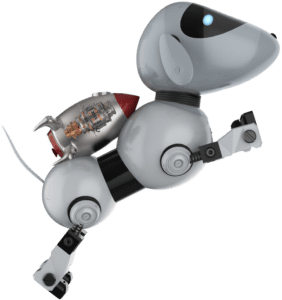Menu


Reflection
A Robot's Guide To Worry Part 5: Reflection
Here is Part 5 in our series on worry. In this part, we will be focusing on a tool that will help us reflect on our own thought process: journaling. Make writing a habit, and you will supercharge your natural problem-solving and decision-making abilities.
Reflection Through Writing
Our brains work differently when we write as opposed to when we allow our thoughts to move in a less structured way. Journaling about your problems helps you work through them. A big reason for this is that we can better reflect on our own thought process when writing. We can only ever have one thought at a time; by getting our thoughts out of our heads and onto paper, we are better able to process them further and generate new ideas. By externalizing our thoughts, we gain new perspective. When writing, it is easier to analyze our conclusions, assumptions, and the possibilities available to us. We can more readily identify holes in our logic and notice things we may have overlooked. 
Remember, problem-solving and decision-making are mechanical activities. By putting your thought process on paper, you will be helping your Unconscious Supercomputer and Conscious Thinking System move back and forth in their cycles of information processing. By writing and then looking at what you have written, you are assisting the mechanical operations required for creative and well-thought-out plans of action.
Additionally, writing causes our thought process to become more linear. Have you ever noticed that talking things out with a friend can be quite helpful? One significant reason for this is that it forces you to take all the relevant information and lay it out in a sequential, logical fashion. The very process of doing this for the sake of your friend’s comprehension is also of great benefit to you. It can help you untangle things and gain clarity. For this reason, think of writing about your problems in terms of having a conversation with yourself.
Furthermore, the linear process of writing will help keep you in problem-solving mode and remain focused. When dealing with emotionally charged issues, the natural movement of our thoughts makes it easy for us to get wrapped up in anxious loops, treading the same ground over and over again. Writing helps to keep your thought process moving forward.
Journaling
In terms of how to journal, keep it simple and natural. Don’t worry about grammar. Write in fragments if you would like. Where appropriate, make lists. Don’t feel the need to explain yourself fully and cover every aspect of the situation; this is for your eyes only. Just put down what is useful to you and focus on the parts that feel particularly sticky. 
The intent of this journal is not to document your life. It is likely not something you will look back on years in the future. That said, when dealing with an ongoing issue, it can be useful to look back at your entries from past days and weeks to see how your thought process has been evolving on the subject. Consider taking up journaling as a daily habit. Write for five to fifteen minutes a day about whatever is on your mind.
An excellent first move when you sit down to write is simply to flow with your stream of consciousness. Just put down on paper whatever comes to you initially. Start having a conversation with yourself. Begin by writing down whatever your problem is. Beneath that, write, “what should I do about this?” Then start answering yourself.
We will now discuss a few particular ways to journal. Use any of these as a guide. That said, don’t feel the need to stick to any particular one. There is much wisdom in your intuitive flow, and just putting down on paper whatever is going through your mind is all you need to do. Simply have a conversation with yourself. There is magic in this process.
Writing Prompt: Analyzing the Options
As mentioned above, one of the most significant benefits of journaling is that it helps you more effectively analyze a situation. In the case of using your journal to help you make a decision, a great place to start is to list your various options. Under each option, put down the pros and cons. Write about your main reasons for preferring each option. Take a step back and look at these driving forces. Are some of these big reasons clearly not good reasons to base your decision upon? For example, is the judgment of others pushing you away from what you otherwise know to be best?
To further your logical analysis, write down what you think the likely outcome would be for each potential decision. Write down why you think this result is expected. What is your best guess as to the chances that this will come to be the case? Assign a numerical probability to each possible result. Are you allowing the fear of a highly unlikely outcome to have too great an influence on this decision?
Aside from analyzing all the logical factors involved in the situation, we also want to turn our analytical brain towards our emotions. When you consider each option, what is your initial feeling? When you imagine this option, does it fill you with energy, or does it take it away? What part of this option excites you? What part brings up anxiety? Pretend you have made this choice. Visualize what your life will be like in the future, one year from now, five years from now. How do you feel about this future scene you are imagining? Write about all of this.
It can be tempting to think that we should leave emotion out of our decisions. Though this view is commonplace, it usually should NOT be the case. Your feelings are a rich source of information. You want to be critical and consider what might be driving your emotions, but you certainly should take them into consideration. Recall that one of the main ways your Unconscious Supercomputer expresses its wisdom is through emotion. A large body of research shows that many situations benefit from a “going with your gut” approach. Your Supercomputer knows much more than you are consciously aware of. For an in-depth discussion on snap decisions, I recommend Blink by Malcolm Gladwell. 
Thus, considering what your heart is telling you is usually an important factor to weigh when decision-making. That said, these feelings should always be subject to analysis by the Conscious Thinking System to help you judge the validity of this advice you are receiving. Do you feel strongly about one of the options in a positive way? Chances are there is a lot of wisdom here. To double-check this feeling, ask yourself what unconscious motivations might be at play here. Does this option feel good because it is allowing you to take the easy way out?
Alternatively, do you feel strongly about one of the options in a negative way? If so, dig deeper. Write about why you think you feel this way. Ask yourself if fear is the driving force behind these negative feelings. Identifying what you are afraid of can be a powerful exercise. Our fears can frequently be irrational, based in deep parts of our caveman brains that guide us in directions that no longer serve us. The intense fear of the judgement of others has its roots in tribal life and often fits into this category.
Irrational fear can keep you from doing the things that you otherwise know you should do. At certain crossroads, you can use fear as a guiding principle; it can help you see the ideal way forward by pointing you towards the uncomfortable thing that you know deep down you should do. By writing things down and trying to work through your feelings, your true motivations may come to the surface. This process will help you gain insight into which feelings you should embrace and move with, and which ones you should attempt to resist.
Writing Prompt: Helping a Friend
Imagine that you have a friend who is going through the same thing you are now and encountering a lot of the same worries. Write out the advice that you would give to this friend. We are often much more critical of ourselves than we are of others. By imagining that you are advising your friend, you may realize that you are being too hard on yourself.
Another way to use the perspective of a friend is to help you generate some clarifying questions. When a friend comes to us with a problem, we typically become curious about the situation and ask them for more details. Our curiosity serves as an instinctive guide to asking questions that will help our friend by providing clarity and encouragement. Make a list of some of the questions you might ask your friend in a situation like this. Let curiosity be your guide. Then take them one by one and answer them from your own perspective in your journal.
Writing Prompt: Breaking Things Down
As discussed in the previous part of the series, big decisions take time, and many tricky problems are resolved incrementally. In these cases, allow the process to slowly unfold over multiple days and multiple journaling sessions. Write about different ideas, different options, and why you think you feel the way you do. Sleep on it and revisit your writing the next day.
We often hesitate to work on big problems because thinking about all that we must do for ultimate resolution is overwhelming. There are certainly times when you want to take a wide view and think about big picture strategy, but keep your focus up close and specific during your typical journaling session. If you think you need to have a bulletproof plan before you can get to work—one with every twist and turn mapped out—you will never get started on anything. 
Grab your journal and break your problems down. Often, we cannot properly determine the best course of action for later stages until we get through the earlier ones. Don’t worry about all these now. Go step-by-step. We only ever need to do one thing at a time. Identify the next action that you need to take. As you get closer to the later steps, the resolution of the previous ones will provide important details and make the decision landscape more solid. The path forward will become more clear as you approach these later steps that seem intimidating in the distance.
In your journal, have a page that has a list of all your major projects. Under each project, list the next action that needs to be taken. For a given project, do you need more information before taking your next action? If so, seeking out this information is your next action. Write down what you need to know and how you intend to go about finding it out.
Writing Prompt: You Contain Multitudes
Do I contradict myself? Very well, then I contradict myself, I am large, I contain multitudes.
– Walt Whitman
We all contain many parts. Evolution is a clunky process, and it has added layer after layer, system after system to your brain over the millennia. These different systems govern different areas of your life, have their own areas of expertise, and have their own agendas. This is why we so often feel conflicted. There is a part of us that wants to eat the glazed doughnut, and there is another part that wants to make the healthy choice. 
Our brain is designed to guide us via the competition between different systems, each representing a different agenda and course of action. From the standpoint of evolution and efficient information processing, this part of our psychology is well designed. Despite its effectiveness, this aspect of our mind causes us a good bit of tension and emotional turmoil. Though it would be nice if we were designed otherwise, we can use this architecture to our advantage.
There is power in coming to know your different parts. There are parts of you that are scared and perhaps too sensitive to the opinions of others, while there are also parts that are heroic and brave and want to take bold action. None of these parts are good or bad. All of your parts are essential, have a role to play, and are deserving of your love and acceptance. They are all you. Each one is looking out for your best interest in the only way it knows how. For example, your more sensitive parts express fear and insecurity because they are trying to protect you from all the possible things that could go wrong.
As you work through your problems on paper, get in touch with the different parts that are advocating for the various options you are considering. Find the part of you that is scared and gently sympathize with it and try to ease its mind; it is only trying to protect you after all. Then look for some of the more bold parts and have conversations with them.
Which part of yourself is advocating for the course of action that will make you most proud? Which is pushing you towards a life where you are fulfilled and realize your potential? Get in touch with the part of yourself that yearns to take you where you want to go. Give it a name. Have a dialogue in your journal with this part of yourself. Ask this part what you should do and then respond in your journal by giving advice from the perspective of this part. 
Though it might seem like the course of action suggested by this bold part is so far beyond your comfort zone that it is not practically worth considering. Don’t let this stop you; this writing assignment can still be a very productive exercise. Most situations we face contain many shades of gray. Brainstorm some of the more bold courses of action you could take. Allow your inner lion to speak. Get your brain churning, and your Supercomputer might come up with a path forward that represents the perfect shade of gray, one that pushes you a little farther than you thought you could go. By channeling this bold part, you can find strength you didn’t know you had. Remember, you are much more capable than you consciously realize.
Onward
This brings us to the conclusion of A Robot’s Guide To Worry. If you found this guide helpful, please let me know at jay@confidentrobot.com. Further, if you have any questions about the material presented here, please send them to me. I enjoy connecting with readers and getting feedback. I might be able to use your question as a base for a future blog post. Thanks for tuning in.
